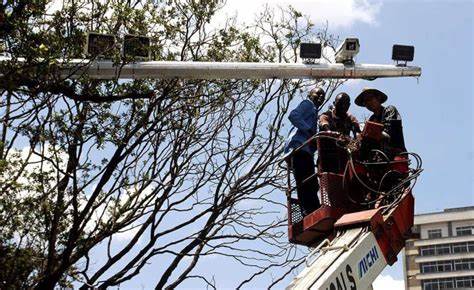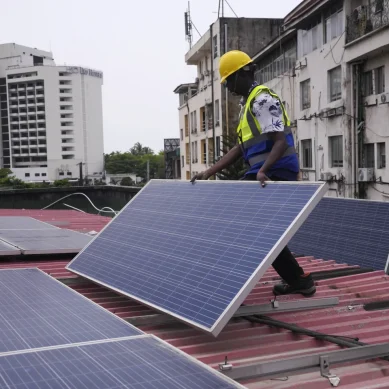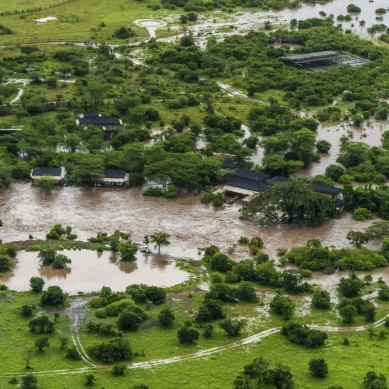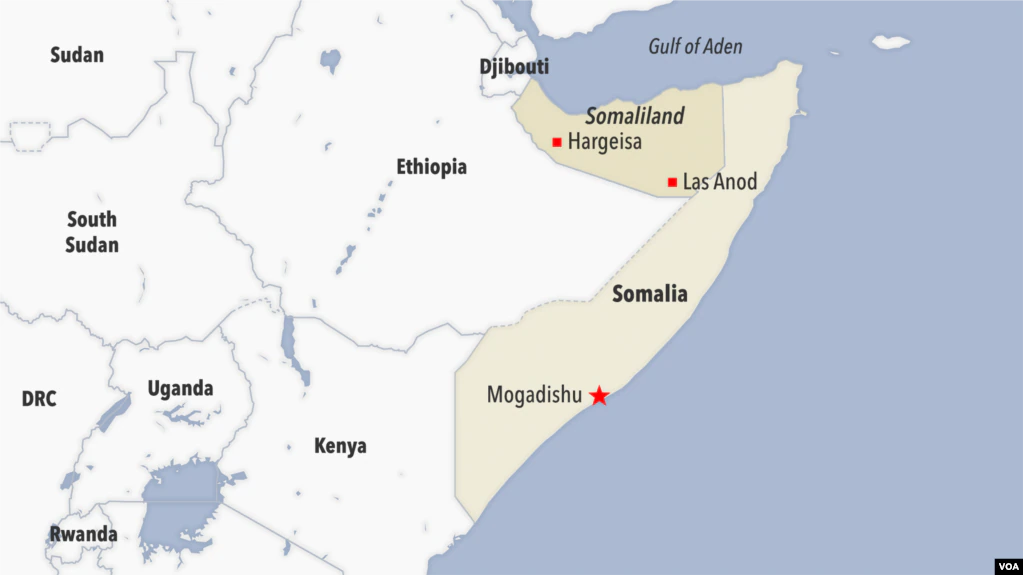
Lights, cameras, what action? In Nairobi, the question looms large for millions of Kenyans, whose every move is captured by the flash of a CCTV camera at intersections across the capital.
Although government promises of increased safety and better traffic control seem to play on a loop, crime levels here continue to rise. In the 1990s, Nairobi, with its abundant grasslands, forests and rivers, was known as the “Green City in the Sun.”
This is part a series of multimedia collaborations on evolving systems of surveillance in medium-sized cities around the world by photographers at Magnum Photos, data geographers at the Edgelands Institute, an organisation that explores how the digitalisation of urban security is changing the urban social contract, and essayists commissioned by Coda Story.
I see it every time I venture into Nairobi’s Central Business District. Navigating downtown Nairobi on foot can feel like an extreme sport. I clutch my handbag, keep my phone tucked away and walk swiftly to dodge “boda boda” (motorbike) riders and hawkers whose claim on pedestrian walks is quasi-authoritarian.
Every city street is dotted with cameras. They fire off a blinding flash each time a car drives past. But other than that, they seem to have little effect. I have yet to hear of or witness an incident in which thugs were about to rob someone, looked up, saw the CCTV cameras then stopped and walked away.
Nairobi launched its massive traffic surveillance system in 2014 as the country was grappling with a terrorism crisis. A series of major attacks by al-Shabab militants, including the September 2013 attack at Nairobi’s Westgate shopping complex in which 67 people were killed, left the city reeling and politicians under extreme pressure to implement solutions. A modern, digitized surveillance system became a national security priority. And the Chinese tech hardware giant Huawei was there to provide it.
A joint contract between Huawei and Kenya’s leading telecom, Safaricom, brought us the Integrated Urban Surveillance System, and we became the site of Huawei’s first “Safe City” project in Africa. Hundreds of cameras were deployed across Nairobi’s Central Business District and major highways, all networked and sending data to Kenya’s National Police Headquarters. Nairobi today boasts nearly 2,000 CCTV cameras citywide.
From biometrics to surveillance – when people in power abuse technology, the rest of us suffer.
On paper, the system promised the ultimate silver bullet: It put real-time surveillance tools into the hands of more than 9,000 police officers to support crime prevention, accelerated responses and recovery. Officials say police monitor the Kenyan capital at all times and quickly dispatch first responders in case of an emergency.
But do the cameras work? Nine years since they were installed, it is hard to see the benefits of these electronic eyes that follow us around the city day after day.
Early on, Huawei claimed that from 2014 to 2015, crime had decreased by 46 per cent in areas supported by their technologies, but the company has since scrubbed its website of this report. Kenya’s National Police Service reported a smaller drop in crime rates in 2015 in Nairobi, and an increase in Mombasa, the other major city where Huawei’s cameras were deployed. But by 2017, Nairobi’s reported crime rates surpassed pre-installation levels.
According to a June 2023 report by Coda’s partners at the Edgelands Institute, an organisation that studies the digitalisation of urban security, there has been a steady rise in criminal activity in Nairobi for nearly a decade.
So why did Nairobi adopt this system in the first place? One straightforward answer: Kenya had a problem, and China offered a solution. The Kenyan authorities had to take action and Huawei had cameras to sell. So they made a deal.
Nairobi’s surveillance apparatus today has become part of the “Digital Silk Road” – China’s quest to wire the world. It is a central component of the Belt and Road Initiative, an ambitious global infrastructure development strategy that has spread China’s economic and political influence across the world.
This hasn’t been easy for China in the industrialised West, with companies like Huawei battling sanctions by the US and legal obstacles both in the UK and European Union countries. But in Africa, the Chinese technology giant has a quasi-monopoly on telecommunications infrastructure and technology deployment. Components from the company make up around 70 per cent of 4G networks across the continent.
Chinese companies also have had a hand in building or renovating nearly 200 government buildings across the continent. They have built secure intra-governmental telecommunications networks and gifted computers to at least 35 African governments, according to research by the Heritage Foundation.
Grace Bomu Mutung’u, a Kenyan scholar of IT policy in Kenya and Africa, currently working with the Open Society Foundations, sees this as part of a race to develop and dominate network infrastructure, and to use this position to gather and capitalize on data that flows through networks.
“The Chinese are way ahead of imperial companies because they are approaching it from a different angle,” she told me. She posits that for China, the Digital Silk Road is meant to set a foundation for an artificial intelligence-based economy that China can control and profit from.
Mutung’u derided African governments for being so beholden to development that their leaders keep missing the forest for the trees. “We seem to be caught in this big race. We have yet to define for ourselves what we want from this new economy.”
The failure to define what Africa wants from the data-driven economy and an obsession with basic infrastructure development projects is taking the continent through what feels like another Berlin scramble, Mutung’u told me, referring to the period between the 19th and early 20th centuries that saw European powers increase their stake in Africa from around 10 per cent to about 90 per cent.
“Everybody wants to claim a part of Africa,” she said. “If it wasn’t the Chinese, there would be somebody else trying to take charge of resources.” Mutung’u was alluding to China’s strategy of financing African infrastructure projects in exchange for the continent’s natural resources.
Nairobi was the first city in Africa to deploy Huawei’s Safe City system. Since then, cities in Egypt, Nigeria, South Africa and a dozen other countries across the continent have followed suit. All this has drawn scrutiny from rights groups who see the company as a conduit in the exportation of China’s authoritarian surveillance practices.
Indeed, Nairobi’s vast web of networked CCTV cameras offers little in the way of transparency or accountability, and experts like Mutung’u say the country doesn’t have sufficient data protection laws in place to prevent the abuse of data moving through surveillance systems. When the surveillance system was put in place in 2014, the country had no data protection laws. Kenya’s Personal Data Protection Act came into force in 2019, but the Office of the Data Protection Commissioner has yet to fully implement and enforce the law.
In a critique of what he described at the time as a “massive new spying system,” human rights lawyer and digital rights expert Ephraim Kenyanito argued that the government and Safaricom would be “operating this powerful new surveillance network effectively without checks and balances.” A few years later, in 2017, Privacy International raised concerns about the risks of capturing and storing all this data without clear policies on how that data should be treated or protected.
There was good reason to worry. In January 2018, an investigation by the French newspaper Le Monde revealed that there had been a data breach at the African Union headquarters in Addis Ababa following a hacking incident. Every night for five years, between 2012 and 2017, data downloaded from AU servers was sent to servers located in China.
The Le Monde investigation alleged the involvement of the Chinese government, which denied the accusation. In March 2023, another massive cyberattack at AU headquarters left employees without access to the internet and their work emails for weeks.
The most recent incident brought to the fore growing concerns among local experts and advocacy groups about the surveillance of African leaders as Chinese construction companies continue to win contracts to build sensitive African government offices, and Chinese tech companies continue to supply our telecommunication and surveillance infrastructure. But if these fears have had any effect on agreements between the powers that be, it is not evident.
In addition to police surveillance, many businesses and private homes have CCTV cameras watching the streets. As the cameras on the streets of Nairobi continue to flash, researchers continue to ponder how, if at all, digital technologies are being used in the approach to security, coexistence and surveillance in the capital city.
The Edgelands Institute report found little evidence linking the adoption of surveillance technology and a decrease in crime in Kenya. It did find that a driving factor in rising crime rates was unemployment. For people under 35, the unemployment rate has almost doubled since 2015 and now hovers at 13.5 per cent.
In a 2022 survey by Kenya’s National Crime Research Centre, a majority of respondents identified community policing as the most effective method of crime reduction. Only 4.2 per cent of respondents identified the use of technology such as CCTV cameras as an effective method.
And the system has meanwhile raised concerns among privacy-conscious members of society regarding potential infringement upon the right to privacy for Kenyans and the technical capabilities of these technologies, including AI facial recognition. The secrecy often surrounding this surveillance, the Edgelands Institute report notes, complicates trust between citizens and the state.
It may be some time yet before the lights and the cameras lead to action.
- A Tell / Coda report











